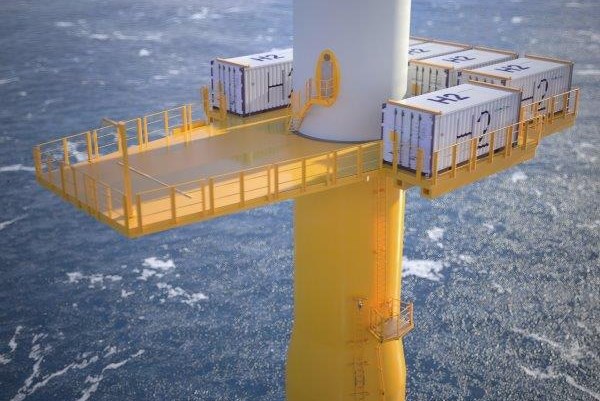Offshore wind-to-hydrogen infrastructure development incorporates Strohm TCP, Siemens Gamesa electrolyzers
Concept for decentralized green hydrogen generation replaces power cables with subsea thermoplastic pipes to transport energy generation from turbine to shore.

Photo Credit: Siemens Gamesa Renewable Energy (SGRE)
Strohm (previously Airborne Oil & Gas, IJmuiden, Netherlands), the manufacturer of fully bonded, thermoplastic composite pipes (TCP), has signed a memorandum of understanding (MOU) with offshore wind leader Siemens Gamesa Renewable Energy (SGRE, Zamudio, Spain).
The collaboration will focus on developing hydrogen transfer solutions that improve the decentralized green hydrogen concept, through which green hydrogen is generated in each wind turbine generator and transported to shore by a subsea pipe infrastructure (learn more about composite developments in this area, “Composites protect subsea cables for offshore wind power”), replacing power cable infrastructure. Under this collaboration, SGRE has a technical advisory role.
Strohm’s TCP product, particularly suited for carrying hydrogen offshore and subsea, is produced at its plant in the Netherlands. According to the company, the corrosion-resistant technology does not fatigue or suffer from issues associated with using steel pipe for hydrogen, such as embrittlement. Manufactured in long, spoolable lengths and flexible in nature, the pipe can be pulled directly into the wind turbine generator, quickly and cost-effectively building an offshore wind farm infrastructure. TCP does not require any maintenance and is suitable for more than 30 years in operation, reportedly lowering the levelized cost of electricity (LCOE) to a minimum.
“This is an exciting collaboration, working with Siemens Gamesa to understand how TCP can be the missing link in an offshore wind farm, generating green hydrogen,” says Martin van Onna, chief commercial officer at Strohm. “Our proven track record with TCP offshore is a prerequisite to be considered a solution in future green hydrogen.”
Similarly, SGRE reports it has already taken significant steps in shaping the wind industry and developing the basis for a decentralized offshore that fully integrates an electrolyzer into an offshore wind turbine, with benefits such as CAPEX reduction, increase of system efficiency and increase of wind farm uptime.
“At Siemens Gamesa, we believe in the potential of green hydrogen and have been working on the decentralized concept for some years,” concludes Finn Daugaard Madsen, innovation manager – Power to X at Siemens Gamesa. “Strohm has supported us through several case studies, identifying the solutions that can be readily used which complement our own systems. This partnership will assist us to innovate together in an open format, accelerating the availability of green hydrogen.”
Related Content
-
Carbon fiber in pressure vessels for hydrogen
The emerging H2 economy drives tank development for aircraft, ships and gas transport.
-
TU Munich develops cuboidal conformable tanks using carbon fiber composites for increased hydrogen storage
Flat tank enabling standard platform for BEV and FCEV uses thermoplastic and thermoset composites, overwrapped skeleton design in pursuit of 25% more H2 storage.
-
PEEK vs. PEKK vs. PAEK and continuous compression molding
Suppliers of thermoplastics and carbon fiber chime in regarding PEEK vs. PEKK, and now PAEK, as well as in-situ consolidation — the supply chain for thermoplastic tape composites continues to evolve.














.jpg;maxWidth=300;quality=90)

